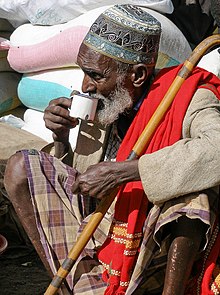Izaar

An izaar, also izar or ʾizār (Arabic: إِزَار),[1] also known as ṣārūn (صارون), futah (فُوطَة),[2] maʿawaz (مَعَوَز),[3] wizar (وِزَار),[4][5] maqtab (مَقْطَب)[6][7] is a traditional lower garment that is frequently used by men in Oman, Somalia, United Arab Emirates and Yemen. Izaars are commonly used in Yemen, it is commonly referred to as maʿawaz (مَعَوَز) and the Hadhrami people call it ṣārūn (صارون) in their local dialect. It is also used by some in Iraq, Kuwait, Bahrain, Saudi Arabia and Qatar, and the Horn of Africa (Djibouti, Ethiopia and Eritrea). A white izaar is typically worn underneath thawbs in Oman and the UAE instead of sirwar pyjamas. Izzars are similar to lungis and sarongs, worn in India, Indonesia, Malaysia, Bangladesh, Pakistan and countries in some parts of East Africa.
Uses[edit]
Izzars are commonly worn by Yemenis at home, and work.[8] It is also worn in the city of Aqaba. Some of these may feature tassels.
Similar garments[edit]
The izaar may be considered synonymous with the lungi in the Indian subcontinent and with the macawiis (معويس) in the Horn of Africa. It may also be considered a type of sarong (spelt saroun صارون in Arabic).
See also[edit]
References[edit]
- ^ Ayman Al Arabi (2010). "Methods of Weaving and Embroidering the Yemenite Fouta: A Descriptive, Analytic Study". Jordan Journal of Arts. 3 (1).
- ^ Category: Yemen. "Yemeni traditional dress. Yemen is a country with a remarkably diverse fashion". Nationalclothing.org. Retrieved 9 May 2023.
- ^ "تعز ثالث أهم محافظات الجمهورية". Archived from the original on 7 October 2016. Retrieved 23 May 2016.
- ^ "Exploring Saudi Arabia: Tihama and Faifa".
- ^ "Chriss Pivey's Blog - Most useful blog for chemicals information". Chrisspivey.org. Retrieved 9 May 2023.
- ^ "26 September News". Archived from the original on 3 January 2020. Retrieved 23 May 2016.
- ^ Spencer, James. "Archived copy" (PDF). Archived from the original (PDF) on 7 October 2016. Retrieved 23 May 2016.
{{cite web}}: CS1 maint: archived copy as title (link) - ^ ICharacter and Morals By Muhammad Saed Abdul-Rahman
